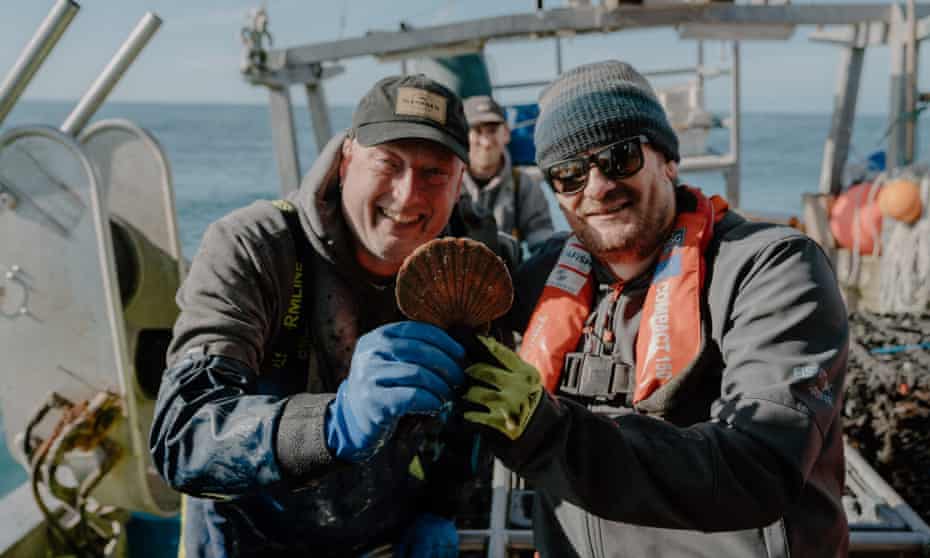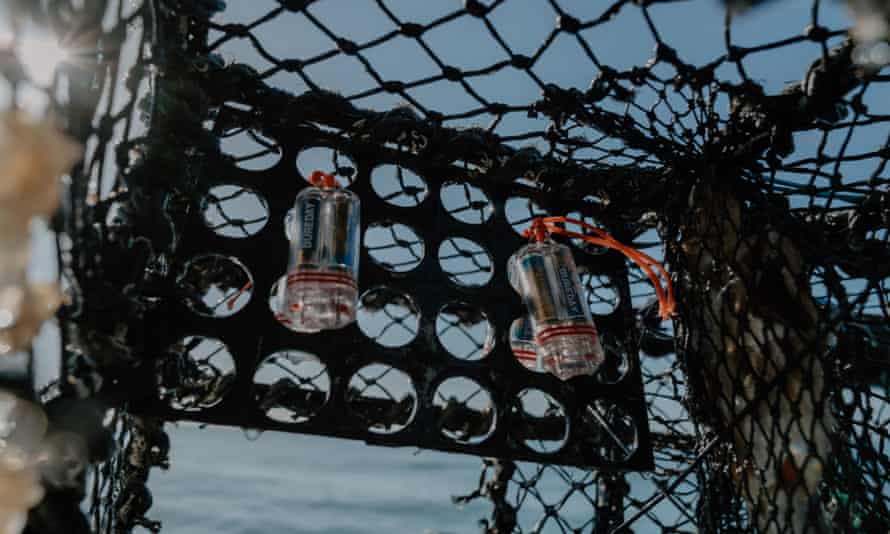Scientists hail breakthrough that could maximise catches while reducing damage caused by fishing

The marine scientist Dr Rob Enever and his team at Devon-based Fishtek Marine designed small underwater ‘potlights’ to help protect fish stocks by replacing the need to use fish to bait crab and lobster pots.
About this content
Anna Turns
Wed 18 May 2022
An unusual technique for catching scallops that was stumbled upon accidentally by scientists could potentially reduce some of the damage caused to our seabeds by fishing.
The marine scientist Dr Rob Enever and his team at Fishtek Marine, a fisheries consultancy based in Devon, designed small underwater “potlights” to help protect fish stocks by replacing the need to use fish to bait crab and lobster pots.
The lights were supposed to attract crabs into the pots. But quite unexpectedly, scallops, which can have up to 200 eyes, were more attracted to the LED lights. “It’s like a scallop disco – illuminate the trap and they come in. It’s astonishing that no one else has discovered this before. It’s quite an exciting find,” said Enever.
Scallops jump into pots with ‘disco’ lights in potential new fishing strategy – video
“This has the potential to open up a whole new inshore fishery and that’s a global first.”
Commercially, scallops are the most valuable fishery in England and the fourth most valuable in the UK, according to the latest government sea fisheries statistics. Most are caught by dredging, which at an industrial-scale is damaging to marine habitats. However, using scuba divers to hand-pick them is labour intensive, time-consuming and therefore more expensive.
Enever hopes scallop potting could create a low-input, low-impact fishery that supplements the income of crab and lobster fishers with this high-value catch.
Advertisement
In 2019, Enever, who specialises in reducing the impacts of fishing on the marine environment using technology, trialled the potlights with the Newlyn-based fisher Jon Ashworth off the Cornish coast. Although Ashworth did not notice any difference in crab or lobster catches, he found huge numbers of European king scallops in his pots.
Anna Turns
Wed 18 May 2022
An unusual technique for catching scallops that was stumbled upon accidentally by scientists could potentially reduce some of the damage caused to our seabeds by fishing.
The marine scientist Dr Rob Enever and his team at Fishtek Marine, a fisheries consultancy based in Devon, designed small underwater “potlights” to help protect fish stocks by replacing the need to use fish to bait crab and lobster pots.
The lights were supposed to attract crabs into the pots. But quite unexpectedly, scallops, which can have up to 200 eyes, were more attracted to the LED lights. “It’s like a scallop disco – illuminate the trap and they come in. It’s astonishing that no one else has discovered this before. It’s quite an exciting find,” said Enever.
Scallops jump into pots with ‘disco’ lights in potential new fishing strategy – video
“This has the potential to open up a whole new inshore fishery and that’s a global first.”
Commercially, scallops are the most valuable fishery in England and the fourth most valuable in the UK, according to the latest government sea fisheries statistics. Most are caught by dredging, which at an industrial-scale is damaging to marine habitats. However, using scuba divers to hand-pick them is labour intensive, time-consuming and therefore more expensive.
Enever hopes scallop potting could create a low-input, low-impact fishery that supplements the income of crab and lobster fishers with this high-value catch.
Advertisement
In 2019, Enever, who specialises in reducing the impacts of fishing on the marine environment using technology, trialled the potlights with the Newlyn-based fisher Jon Ashworth off the Cornish coast. Although Ashworth did not notice any difference in crab or lobster catches, he found huge numbers of European king scallops in his pots.

The lights were supposed to attract crabs into the pots but unexpectedly scallops were more attracted to the LED lights.
Photograph: Simon Hird/Fishtek Marine
“Pretty much every pot that we hauled had scallops in them and yet every haul without lights had no scallops. It was conclusive, there and then,” said Ashworth. “To have proof that lights can be used to catch scallops has got to have some awesome implications looking forward.”
In further experiments, a total of 1,886 pots were hauled – 985 experimental pots with lights caught 518 scallops; 901 control pots without lights caught only two. Overall, 99.6% of scallops were caught in pots with lights. This research, funded by Defra and Natural England, is outlined in a peer-reviewed paper published in the Journal of Fisheries Research this week.
“Pretty much every pot that we hauled had scallops in them and yet every haul without lights had no scallops. It was conclusive, there and then,” said Ashworth. “To have proof that lights can be used to catch scallops has got to have some awesome implications looking forward.”
In further experiments, a total of 1,886 pots were hauled – 985 experimental pots with lights caught 518 scallops; 901 control pots without lights caught only two. Overall, 99.6% of scallops were caught in pots with lights. This research, funded by Defra and Natural England, is outlined in a peer-reviewed paper published in the Journal of Fisheries Research this week.

In experiments, of 1,886 pots hauled, 985 pots with lights caught 518 scallops while 901 pots without lights caught only two.
Photograph: Simon Hird/Fishtek Marine
Dr Bryce Stewart, a marine ecologist and fisheries biologist at the University of York, has studied scallops for more than 20 years and co-authored the paper with Evener
Dr Bryce Stewart, a marine ecologist and fisheries biologist at the University of York, has studied scallops for more than 20 years and co-authored the paper with Evener
“This is one of the most exciting things I have come across in my whole career – it’s such a surprise,” said Stewart, who describes scallop eyes as ‘pretty weird’. Scallops can have up to 200 eyes on their mantle, along the inner edges of their shell openings.
“Most animals, including us, have lenses but scallops don’t. They have mirrors at the back of their eyes and they also have two retinas, one which senses darker things, one that senses lighter things, so they can possibly use that contrast to sense movement. Perhaps they prefer illuminated areas because they provide safety from predators or because it’s easier to find the plankton they eat.”
Powered by two rechargeable AA batteries, each small potlight is secured inside the pot and is expected to last between five and 10 years. The trap design has been modified with a ramp for easier access into the modified pot and Enever continues to refine the potlight technology – tank experiments indicate that scallops are more attracted to blue light than white light, for example. If the team can design a light system aimed specifically to catch scallops, that could open up the possibilities of doing this at scale, according to Stewart.
“Scallops are famous for their good vision,” said Dr Vicky Sleight, a marine biologist at the University of Aberdeen. “Scallop eyes have a surprisingly high degree of visual clarity and their attraction to artificial light is intriguing. Follow-up laboratory experiments are required to understand why they are attracted into pots, and if it’s a reliable and reproducible behaviour at a range of different types of scallop sites, then it’s certainly an exciting prospect to grow a more sustainable scallop fishery.”
The Fishtek team are repeating these experiments in four more UK locations, from Lyme Bay to the Orkney Islands, using different trap designs in various conditions and depths.
“Our goal is to get as close to a commercially viable fishery as we can,” added Enever. “I genuinely think we can do that, it’s got mileage.”

No comments:
Post a Comment